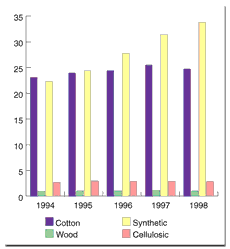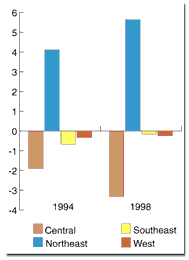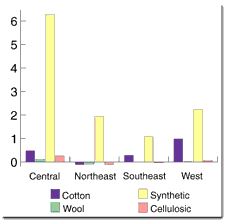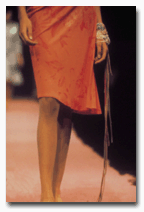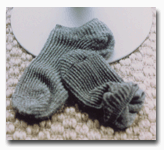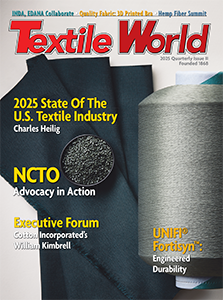W
hen referring to the fluctuation in pricing of cotton during the first month of the new
year, one cotton-fiber respondent said, “January has been a ‘slumpy’ month.” It seems a seasonal
low of 55.16 cents per pound was recorded on Jan. 5. He went on to say that markets were
rebounding, but not yet to the level of the seasonal high of 63.57 cents. This respondent also
said, “One of the reasons for the decline in cotton pricing was the announcement by the Chinese of
increased production.” Other factors could be an increased carryover in cotton, as well as recent
declines in bales being exported.
He mentioned that early surveys indicate farmers will plant increased acreage this year,
with an anticipated harvest of nearly 16 million bales. The increased acreage are attributed to the
fact that competing crops are no better for farmers; therefore, they plan to plant cotton. Alabama
is the only exception, with an anticipated loss in acreage planted in cotton. This decrease is
credited to the lack of irrigation there.
Improved OE Markets
There are mixed reviews, however, from cotton-yarn spinners. While one spinner will report
his markets as being excellent, another will report his markets as slow. Most spinners do say that
they are running full and shipping all they make. Several spinners commented that the market for
open-end (OE) yarns had improved. One went so far as to say, “Our OE markets are very firm. The
increase in pricing is holding, but there is no difference in the way orders are placed. That is,
there is no really long-term business. About the most we can expect is a quarter ahead. Our
customers buy only against firm orders, and today there is very little spot business. We are
running full and actually selling some yarn for other yarn spinners as well.”
Another spinner, commenting on OE yarn sales, said, “There has been a definite rise in the
demand for open-end yarns, and the pricing is firming up. But, current pricing will depend on
spinners not breaking the stand they have taken. The future looks encouraging, and we should have a
pretty good year. The home furnishings market, which is in a major decline, could throw a monkey
wrench into it, however. If their lack of business continues, it could cause a backup of yarn, and
the market could go to hell in a handbasket in a heartbeat. I’m still optimistic, though. It feels
good to be optimistic — it has been awhile.”
Yet another spinner said, “Our markets are slow, especially in outerwear, but hosiery is
shipping well. The Canadian markets are off, which affects us to some degree. Overall, we are
shipping about 80 percent, with some curtailment. Gone are the days when you could dump inventory.
It is much better to adjust manufacturing to control your inventory. We have recently noted an
increase in the demand for OE poly/cotton yarn — due, we think, to the fact that one of our
competitors went out of the OE business.”
Strong Ring Markets
Virtually every ring spinner commented on the markets as being “extraordinary,” “extremely
tight” or any other adjective beginning with “extr-.” Prices are good, and essentially all markets
are pretty firm. This has become the norm for ring-spun (RS) spinners. Hopefully, nothing will
happen to dim the one bright light spinners have come to depend on.
On the other hand, markets for textured yarns are dismal. As one texturizer said, “We have
no pricing problems because there are no buyers. Seriously, home furnishings are down, along with
automotive and apparel. Hosiery is the only area that is holding its own.”
Synthetic spinners are finding their situation very much like that of the texturizer,
although one said, “January was much better than expected. The fourth and first quarters are always
difficult in our markets but, listening to the comments from our customers, I would have to say
that there is a lot of optimism out there.” Spinners of synthetics feel that markets will improve
early in the second quarter, but they qualify their optimism, saying it depends on the general
economy at the start of the second quarter.
Ripple Effect Of Energy Crisis
One spinner expressed his concern about the West Coast energy shortage, specifically in
California. “California is a large consumer of spinners’ products. Lots of knitters out there are
struggling as it is, and with unreliable power, many may have to go out of business. What will
happen to East Coast spinners if they lose this customer base? I have already heard of one finisher
deciding to stop production.”
As media sources have already reported, the effect of California’s problem could be felt in
many areas across the country. Hopefully, the problem will be solved, or at least alleviated, soon.
March 2001

